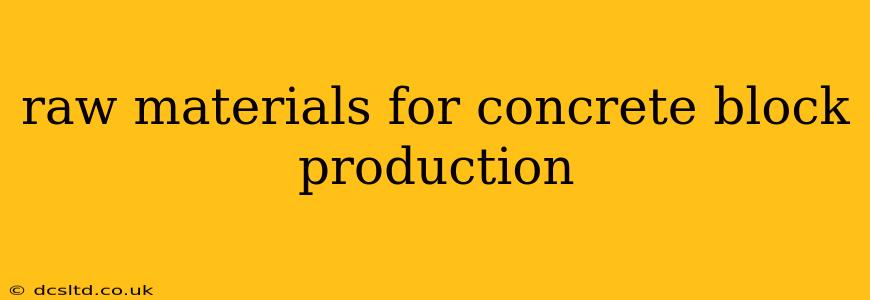Concrete blocks, ubiquitous in construction worldwide, are manufactured using a blend of carefully selected raw materials. Understanding these components is crucial for producing high-quality, durable blocks that meet specific project requirements. This comprehensive guide delves into the essential raw materials, exploring their individual roles and the impact of variations in their properties.
What are the Main Raw Materials Used in Concrete Block Production?
The primary components of concrete blocks are:
-
Cement: This binding agent is the backbone of the block, providing the necessary strength and durability. Portland cement is most commonly used, but other types like blended cements can also be employed depending on the desired properties and cost-effectiveness. The cement type significantly impacts the block's compressive strength, setting time, and overall longevity.
-
Aggregates: These constitute the bulk of the concrete block's volume. Aggregates are broadly classified into two categories:
- Fine Aggregates: Typically sand, these fill the spaces between the coarser aggregates, improving the workability of the concrete mix and contributing to its overall density. The quality of the sand, specifically its grading and cleanliness, impacts the strength and durability of the final product. Contaminants like clay or silt can significantly weaken the blocks.
- Coarse Aggregates: These are larger particles, usually crushed stone or gravel. They provide the majority of the block's volume and contribute significantly to its compressive strength. The size, shape, and grading of the coarse aggregates are carefully considered to optimize the mix design. Angular aggregates generally produce stronger blocks than rounded ones.
-
Water: Water is essential for the hydration process of cement, triggering the chemical reactions that bind the aggregates together and form the hardened concrete. The amount of water used is critical; too much water weakens the blocks, while too little results in a difficult-to-work-with, dry mix.
What Other Additives Are Used in Concrete Block Production?
Beyond the fundamental components, several additives can be incorporated to enhance specific properties of the concrete blocks:
-
Air-Entraining Agents: These introduce microscopic air bubbles into the concrete mix, improving its resistance to freeze-thaw cycles, especially crucial in colder climates. This significantly enhances the durability and longevity of the blocks, preventing damage from repeated freezing and thawing.
-
Water-Reducing Admixtures: These chemicals reduce the amount of water needed for a given consistency, resulting in stronger, denser blocks with improved workability. This can lead to both cost savings and enhanced performance.
-
Accelerators: These speed up the setting time of the concrete, allowing for faster production cycles. However, careful consideration is necessary to avoid compromising the overall strength and durability of the blocks.
-
Plasticizers: These improve the workability of the concrete mix, making it easier to handle and place in the molds. This is particularly beneficial for automated block-making processes.
How Do Different Raw Materials Affect Concrete Block Quality?
The quality of the raw materials directly impacts the final properties of the concrete block. Using substandard materials can lead to:
-
Reduced Compressive Strength: This is the block's ability to withstand crushing forces, a critical factor for structural integrity. Low-quality aggregates or insufficient cement can significantly weaken the blocks.
-
Increased Porosity: This can lead to higher water absorption, reduced freeze-thaw resistance, and diminished durability.
-
Lower Durability: Blocks made with poor-quality materials are more susceptible to damage from weathering, abrasion, and chemical attack.
-
Inconsistency in Block Dimensions: Variations in aggregate size and grading can lead to inconsistencies in the final block dimensions, affecting the precision and accuracy of construction.
What are the Environmental Impacts of Concrete Block Production?
The production of concrete blocks has significant environmental implications. Cement production, in particular, is a major source of carbon dioxide emissions. Using supplementary cementitious materials (SCMs) like fly ash or slag can reduce the carbon footprint. Additionally, sourcing aggregates locally minimizes transportation costs and emissions. Sustainable practices, such as water recycling and efficient energy use in manufacturing, are essential for minimizing the environmental impact.
What are the Different Types of Concrete Blocks Available?
The properties of concrete blocks can be adjusted by varying the mix design and incorporating different additives. This leads to a variety of concrete blocks suitable for various applications, including:
-
Standard Concrete Blocks: These are the most common type, suitable for a wide range of construction applications.
-
High-Strength Concrete Blocks: These are designed for use in structures requiring greater load-bearing capacity.
-
Lightweight Concrete Blocks: These are manufactured using lightweight aggregates, making them easier to handle and reducing the overall weight of the structure.
-
Insulating Concrete Blocks: These incorporate insulating materials to improve the thermal performance of the building envelope.
By carefully selecting and controlling the raw materials, manufacturers can produce high-quality concrete blocks that meet specific performance requirements while minimizing environmental impact. Understanding the role of each component is vital for producing durable, reliable, and cost-effective construction materials.
